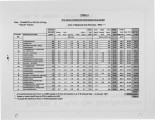| OCR Text |
Show Lynn D. Brown Bechtel Company PAPER NO. 21 Achieving Ultra-low Sulfur Levels "\ in Refinery Fuel Gas ( ~ ~ G. ) ABSTRACT A study was performed to provide the Western States Petroleum Association (WSPA - Los Angeles refiners) with both technical and cost information on "state of the an" hydrocarbon fuel gas desulfurization processes. This repon served to formulate WSPA's input to South Coast (LA) Air Quality Management District's (SCAQMD) proposed control measure F-2 to regulate the total sulfur content in gaseous fuel. The following tasks were performed in preparing this repon: • • • • • An assimilation of existing refinery fuel gas data and operating data from the existing desulfurization systems. A literature and commercial practice survey of hydrocarbon fuel gas desulfurization technologies. The development of a "typical" refinery base case for fuel gas before and after existing treatment from WSP A member data. The solicitation of performance and cost quotations from vendors based on this generalized refinery base case. The conceptual development of potential process schemes to achieve various levels of fuel gas desulfurization. The estimation of the removal efficiencies and the annualized total costs (per unit of sulfur removed) of various proposed process schemes relative to each other. S~YandBACKGROUND Southern California has gradually become an environmental testing ground and bellwether for future U.S. environmental regulatory action. Typically legislation adopted there by agencies such as the South Coast (LA) Air Quality Management District (SCAQMD) is soon adopted for the rest of California by the state agencies such as the Air Resources Board (CARB). Often legislation then filters to the national level via the Environmental Protection Agency (EPA), and can eventually proceed to the international arena. A new rule limiting the sulfur level in industrial fuel gases has been put into force by the SCAQMD. Many petroleum refining processes generate fuel gas (C1-C .. ), the bulk of which is consumed in the refineries to provide energy for the production of petroleum products. These fuel gases contain sulfur components, primarily in the form of hydrogen sulfide (HzS), organic mercaptans (RSH's), carbonyl sulfide (COS) and smaller amounts of sulfides (CS2 , DMS) and disulfides (DMDS). When burned, they will form sulfur dioxide which is a designated "criteria" air pollutant by the EPA Existing Regulations There are federal and regional regulations that set sulfur limits for industrial fuel gas. The federal regulation for new source fuel gas combustion devices in petroleum refineries is listed in Subpan J of EP A's Code of Federal Regulations. It prohibits the burning of fuel gas containing more than 160 ppm of HzS in units constructed or modified after June 11, 1973. The standard does not apply to emergency gas releases or process upsets. There is an equivalency provision in the rule which would allow fuel users to reduce the SOX levels at the point of combusted gas release to an equivalent sulfur level. In refineries, however, with a great number of widespread -1- |



















